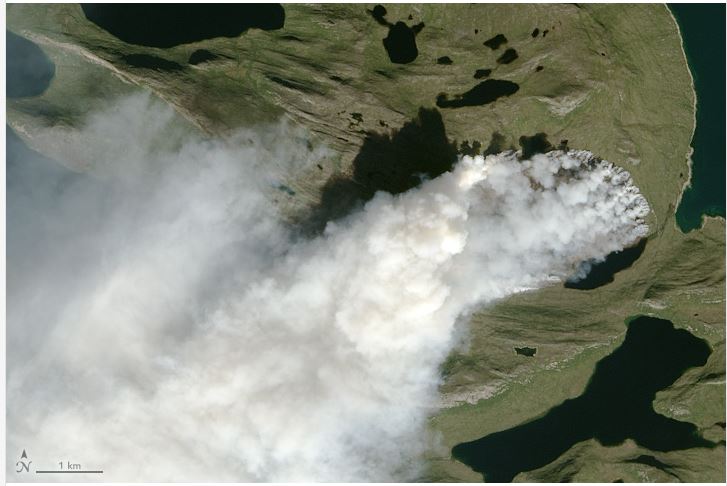
COPENHAGEN, Denmark, August 17, 2017 (ENS) – Greenland, the world’s largest island, known for its vast sheets of ice, is now experiencing its first large wildfire. The fire is burning along the island’s west coast about 150 kilometers (90 miles) northeast of Sisimiut, the second-largest city in Greenland, an autonomous county of Denmark.
Satellites first detected evidence of the fire on July 31. The U.S. National Aeronautic and Space Administration, NASA, says the Moderate Resolution Imaging Spectroradiometer (MODIS) and Visible Infrared Imaging Radiometer Suite on Suomi NPP collected daily images of smoke streaming from the fire over the first week in August.

While it is not unprecedented for satellites to observe fire activity in Greenland, a preliminary analysis by Stef Lhermitte of Delft University of Technology in the Netherlands suggests that MODIS has detected far more fire activity in Greenland in 2017 than it did during any other year since the sensor began collecting data in 2000.
Three-quarters of Greenland is covered by the only permanent ice sheet outside Antarctica. While Greenland is almost entirely covered by this thick ice sheet, there are exposed carbon-rich peatlands along the west coast.
The wildfire appears to be burning in peat, says Miami University scientist Jessica McCarty.
That would mean the fire produced a sharp increase in wildfire-caused carbon dioxide emissions in Greenland for 2017, says atmospheric scientist Mark Parrington of the European Commission’s Copernicus program.
Scientists fear that the fire may have broken out because permafrost is melting, making the underlying peat more likely to catch fire. Since peat can be used as a fuel, it could burn for a long time.
According to Ruth Mottram of the Danish Meteorological Institute, neither the institute nor other scientific groups maintain detailed records of fire activity in Greenland, but many meteorologists at the institute have heard anecdotal fire reports.

The small fires detected in Greenland by satellite are usually campfires lit by hunters or backpackers. But Landsat did capture imagery of another sizable fire in August 2015.
No one knows exactly what triggered this fire, though a lack of documented lightning prior to its ignition suggests the fire may have been sparked by human activity. The area is regularly used by reindeer hunters, and is close to Sisimiut, a town with a population of 5,600 people.
The summer of 2017 has been dry. Sisimiut saw almost no rain in June and half of the usual amount in July. Scientists speculate that may have parched dwarf willows, shrubs, grasses, mosses, and other vegetation that live in Greenland’s coastal areas, making them more likely to burn.
Fires emit soot, black carbon. The prevaling winds are likely to transport some of this material eastward where it will contribute to a line of darkened snow and ice along the western edge of Greenland’s ice sheet.
Climate scientists are watching this area closely because darkened snow and ice melts more rapidly than when it is white.
“In Greenland, everything got warmer at the same time: the air, the ocean surface, the depths of the ocean,” said Ian Joughin, a glaciologist at University of Washington. ‘We don’t really understand which part of that warming is having the biggest effect on the glaciers. What scientists do know is that warming Arctic temperatures – and a darkening surface of the Greenland ice sheet – are causing so much summer melting that it is now the dominant factor in Greenland’s contribution to sea level rise.”
“Greenland’s summer melt season now lasts 70 days longer than it did in the early 1970s. Every summer, warmer air temperatures cause melt over about half of the surface of the ice she,” said Joughin.
Scientists are closely monitoring the contributions of climate change to the start of this fire and also its impacts on the Earth’s climate as a whole.
Copyright Environment News Service (ENS) 2017. All rights reserved.
